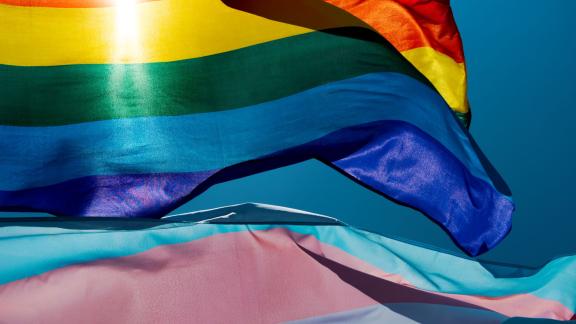Inclusive leadership survey findings

In August 2021, the Health and Care LGBTQ+ Leaders Network conducted a short survey to help us to determine what the current picture of inclusive leadership looks like and what that means for our network members.
We were overwhelmed by the response to the survey on inclusive leadership. This was clearly an issue on which members were keen to have their say. Eighty per cent of the respondents identified as LGBTQ+, with the others identifying as allies. For the most part respondents felt that leadership approaches in their organisations were fairly inclusive, that they were generally experiencing fair treatment in their place of work and tended to feel that diverse opinions were valued.
However, when it came to whether managers at their place of work reflected the diversity of the broader workforce, this was not felt to be the case:
“My organisation has quite a way to go in recognising and dealing with the disparity between the diversity of the broader workforce and the senior and very senior leadership”.
Replies pointed to the lack of LGBTQ+, black and minority ethnic or disabled people in leadership positions, including on boards, calling their leadership “markedly unrepresentative of our population”. Also that: “there are very few if any senior trans leaders in the NHS.”
The responses went on to explore some of the reasons this matters.
Representation, visibility and experience
There was a strong sense that LGBTQ+ experience did not always seem to be a meaningful part of their organisation’s decision-making. One respondent said: “I can say that as an LGBTQ+ member of staff in the NHS and as a leader in the NHS, we do not do enough to consider the needs of LGBTQ+ people.” In particular, one person responded that: “LGBTQ+ equality feels like another exercise that organisations need to be seen to support, but in reality, there is little actual change in culture or practice.” Some expressed frustration that the NHS Staff Survey was not being used to track and meaningfully improve the workforce experience of LGBTQ+ people in their organisation (including frustration that questions about trans and non-binary people were not included in the survey).
Respondents reflected that the perceived lack of prioritisation of LGBTQ+ matters at senior levels may be linked to low representation of LGBTQ+ people at managerial level and above. One made the point that it is hard to secure potential champions for driving progress when it comes to LGBTQ+ matters: “All the managers at exec levels are white, straight and mostly women. It's been a challenge therefore knowing who to approach to lead at exec level on LGBTQ+ stuff.” This can feel challenging because, as another respondent put it: “There is a veneer of inclusive language and some performative allyship, but if you scratch below the surface the same old prejudices are there. Many allies want to appear to be allies, often for their own career progression, but don't really want to change anything.”
When it comes to the importance (and lack) of LGBTQ+ senior leader visibility, some respondents identified a particular challenge: not actually knowing whether or not their leaders are LGBTQ+ people. Unlike many diverse characteristics, the fact of whether a person is LGBTQ+ is not automatically visible. One respondent said: “the senior leadership team and middle managers could definitely be more diverse as well as openly more diverse – i.e. diversity isn't just what you see”.
This lack of visibility was identified as a challenge at all levels of the workforce, and a contributor to the perceived low level of prioritisation. One respondent reflected: “People don't get the 'hidden' aspect about being part of this community, and that I and many others hide ourselves away as we don’t feel accepted - or society makes us fear being who we are and sharing this with people. Lots of the attention goes on protected characteristics you can see (for example black and minority ethnic people) and because (some members of) the LGBTQ+ community hide themselves away, there is an assumption all is ok here and there's nothing to do - but in fact it's the opposite. Because we hide our identity for fear of the impact, we need to work doubly hard to understand our needs.”
Diversity and intersectionality
Respondents raised that they find it particularly important to recognise the complex diversity and intersectionality of staff identities: “we are way more than being from LGBTQ+ community, many of us also are BME, have disability, experience age discrimination etc. But the LGBT side of things we can hide - other things not so much”. The implication was that some parts of people’s identities feel like they are prioritised over others when it comes to diversity-related support in the workplace.
Respondents also pointed to the diversity of experience and needs that exists within the LGBTQ+ community, which extend beyond ‘drop-down lists’ and require deeper conversations. Respondents reflected on the different experiences and needs associated with ’visible’ versus ’invisible’ diverse characteristics, one proposing that: “the needs of our trans colleagues are very different from the needs of say, our gay/lesbian colleagues.”
This respondent went on to reflect that trans people who are “brave enough to transition and cannot hide this” may have experiences associated with their visible differences that “possibly have more in common with the challenges faced by BAME staff” than others such as some lesbian, gay and bisexual people who may not be identifiable as having these diverse characteristics unless they actively share that information. It is interesting that a minority of responses to the survey contained strong anti-trans rhetoric, though analysis suggests this may have come from people responding as part of an anti-trans agenda rather than from network members.
Finally, one respondent said: “I truly believe in this culture being led from the top, it is therefore our priority to embrace diversity across the whole organisation and recognise each person for the unique skills and experiences they bring.” However, this message may not yet be socialised throughout health and care organisations with regard to LGBTQ+ diversity. Respondents raised that when it comes to driving progress, “we expect all the LGBTQ+ work to be done in staff’s own time, as volunteers”. This casts a light on the potential underinvestment and undervaluing of LGBTQ+ matters by organisations’ senior leadership, which may in turn place undue burden and create opportunity cost for these staff (for example, feeling obliged to spend spare time working on matters that have not been allocated corporate capacity in lieu of pursuing development opportunities).
One of the respondents said: “We must work to develop and celebrate the diversity and experience of our workforce so that we might make better decisions and provide better care for our patients.”
Inclusive leadership
It is clear from our survey that inclusive leadership may help to achieve this – and there is certainly more that can be done. These results provide insights into some of the ways in which we can all be more inclusive leaders in health and care.
While coming out at work is a complex and personal decision, LGBTQ+ leaders should not underestimate the positive and potentially transformative impact of being intentionally, actively visible as an LGBTQ+ person in a leadership role.
Leaders who consider themselves to be LGBTQ+ allies should seize opportunities to meaningfully enact their allyship by visibly and proactively championing positive change.
All leaders can further support LGBTQ+ inclusivity by helping ensure adequate time and resources are formally allocated to this work, including to run LGBTQ+ staff networks, and ensure that the impact of all such activity is meaningfully measured and achieving positive outcomes. Organisations, boards, departments and teams should identify whether they lack LGBTQ+ people in leadership roles, and consider developing clear career pathways, support and pipelines for aspiring LGBTQ+ leaders.
Next steps
The Health and Care LGBTQ+ Leaders Network will be engaging with our members directly to develop solutions to some of these challenges and create asks of the healthcare sector leadership to drive progress.



